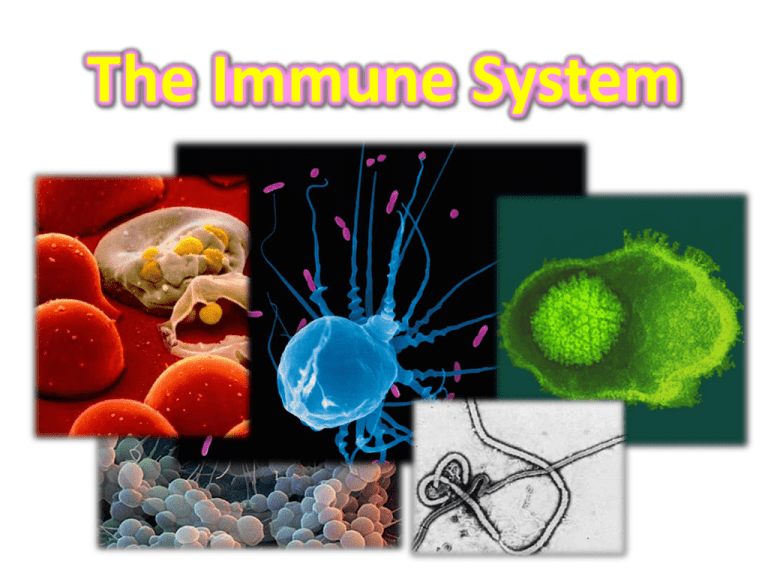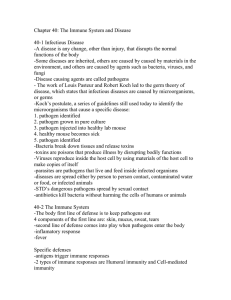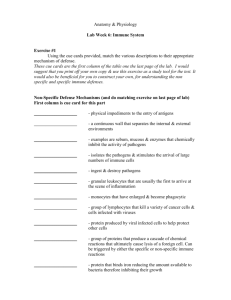The Immune System
advertisement

The Immune System Germ Theory • Germ theory proposes that microorganisms cause diseases (not spirits, as once believed). – Proposed by Louis Pasteur – Led to rapid advances in understanding disease • Supported by Koch’s postulates. – Disease-causing agents, or particles, are called pathogens. There are different types of pathogens • Bacteria are single-celled organisms: – Cause illness by destroying cells, release toxic chemicals – Ex: Food poisoning, MRSA • Viruses are genetic material surrounded by a protein coat: – Force host cells to make more viruses, small – Ex: Flu, Cold, HIV • Fungi can be multicellular or single-celled: – Take nutrients from host cells by piercing healthy cells – Occur in warm and damp places – Ex: Athlete’s foot • Protozoa are single-celled organisms. – Use host cells to complete their life cycles – Take nutrients from host cell – Ex: Malaria Review: Parasite • Pathogens can be transferred by indirect or direct contact. • Indirect contact does not require touching an infected individual. – Touching an infected surface – Breathing in infected air • Vectors :Carry a pathogen and transmit into healthy cells – Ex: Insects (ticks, mosquitoes, fleas), food • Direct contact requires touching an infected individual. – Includes: • Kissing • Sexual intercourse • Hand shaking tick Many body systems protect you from pathogens • The immune system is the body system that fights off infection and pathogens. • Many other tissues and systems help the immune system. – Skin is the (first) physical barrier to infection. – Mucous membranes trap pathogens entering the body. – The circulatory system transports immune cells. Cells and proteins fight the body’s infections • White blood cells attack infections inside the body. – Phagocytes engulf and destroy pathogens. – T cells destroy infected cells. – B cells produce antibodies, which deactivate the pathogen. 3 types of proteins fight off invading pathogens – Complement proteins weaken pathogen membranes. – Antibodies make pathogens ineffective. – Interferons prevent viruses from infecting healthy cells. pathogens antibody 2 1 3 5 6 4 Immunity prevents a person from getting sick from a pathogen • In all types of immunity, pathogens are destroyed before you get sick. – Passive immunity occurs without an immune response. • Mother’s milk • Genetics – Active immunity occurs after a specific immune response. • Having chicken pox – Acquired Immunity occurs after given a vaccine. • Flu shot Antibiotics and antiseptics cause pathogens to burst • Antiseptics kill pathogens outside of the body – Do not target specific pathogens – Ex: Vinegar, Soap, Rubbing Alcohol, Purel • Antibiotics kill pathogens inside the body. – Target one specific bacterium or fungus – NOT effective against viruses • Overuse and misuse of antibiotics can cause medicines to become ineffective. – Some bacteria in a population have genes that make them immune to antibiotics. – These bacteria spread the gene, making the antibiotics useless. A bacterium carries genes for antibiotic resistance on a plasmid. A copy of the plasmid is transferred through conjugation. Resistance is quickly spread through many bacteria. • Vaccines control pathogens and disease – Injected with antibodies that have been exposed to the pathogen. • Gives instant but short- term protection. – Given mild or dead version of the pathogen. • Your body makes the antigens itself for long-term protection. • Memory B cells stay for a long time, ready for another attack from the same organism. How a vaccination provides immunity – Stimulates a specific immune response – Causes memory cells to be produced – Allows immune system to respond quickly to infection – Has a fast response, a person will not get sick 1 memory B cells Antigens in a vaccine trigger an immune response, and memory B cells are made. 2 A memory B cell is stimulated when the real pathogen binds to it. 3 The B cell quickly activates and makes antibodies that fight the pathogens before you get sick.






